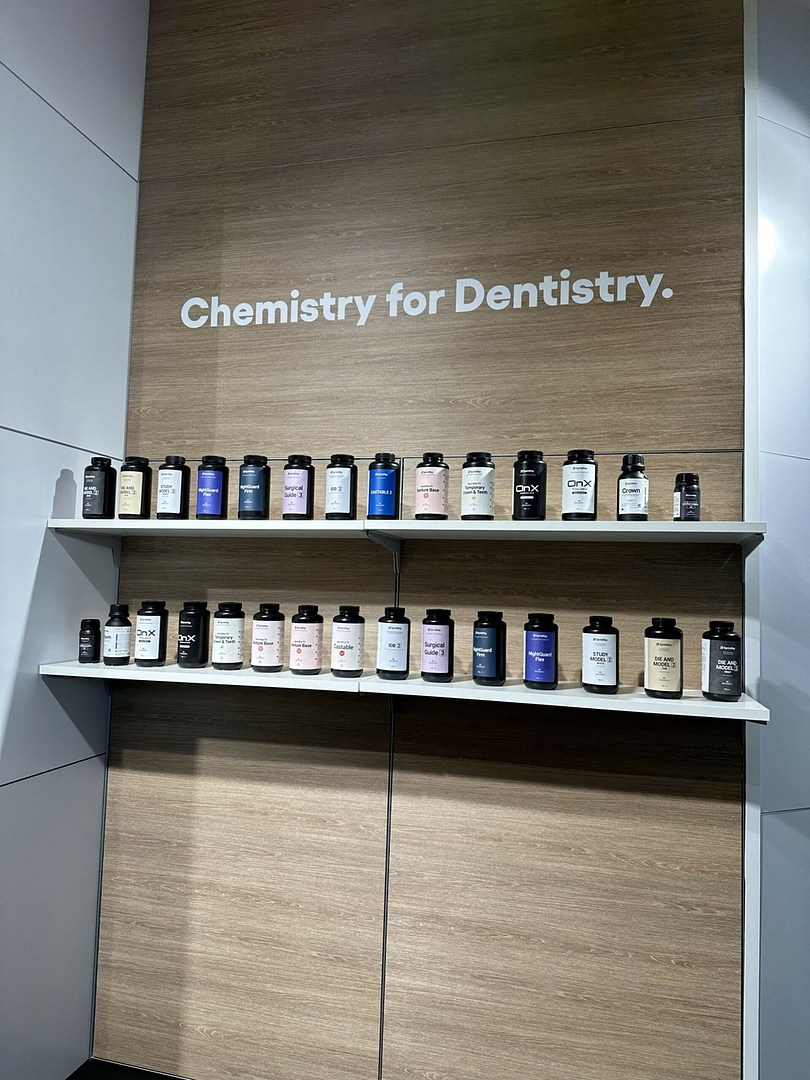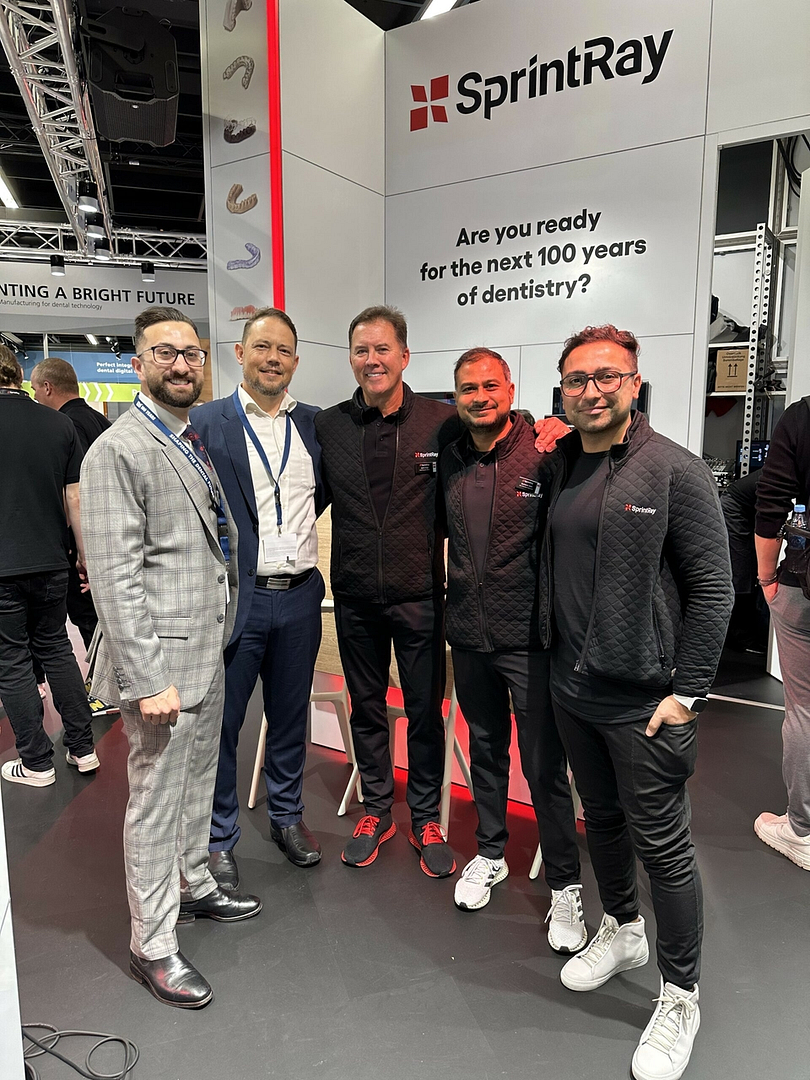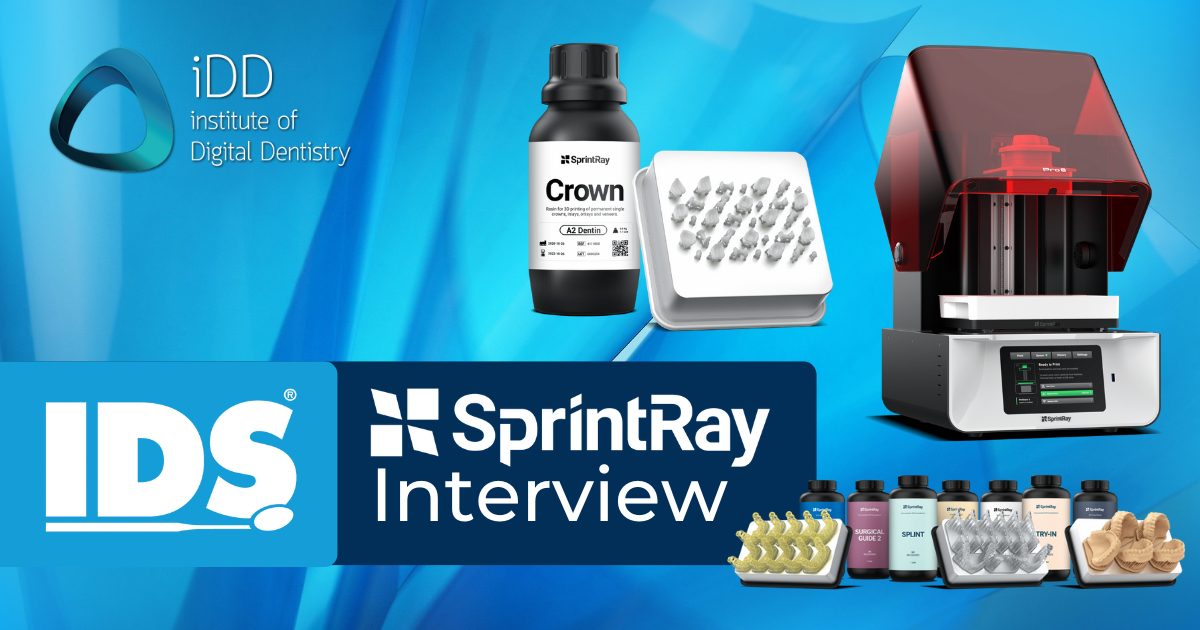3D printing is taking over the dental industry. At almost every trade show or conference we’ve attended in the last year, 3D printing has been the hot topic that dentists flock to.
SprintRay are a company specializing in 3D dental printing ecosystems - and at the very forefront of this exciting new revolution in digital dentistry.
During our recent trip to IDS 2023 in Cologne, we stopped by the SprintRay booth to see what the company has been up to and their plans for the future.
See our full video interview with SprintRay’s Chief Growth Officer John Cox, Vice President of Materials Sumeet Jain and Co-founder and Chief Product Officer Hossein Bassir below, or read the full transcript.
Welcome to IDS! Can you tell us more about your new crown material and print process?
John: Absolutely. We're thrilled to be here at IDS. It is kind of the World Cup of dentistry as everyone knows, and this year we're launching our new crown kits. We're changing the game. We've changed the game so many times with new product innovations, but this one is really having a big impact on dentistry.
The idea was that we could print six crowns, in less than 15 minutes.
We also have a ceramic material, which we just launched in Chicago a couple of weeks ago. It’s able to print in less than 10 minutes. So imagine that, six crowns in less than 10 minutes at a cost of $6 to $7 a unit.
It just kind of blows your mind with what's possible in dentistry. How we've been able to do it is a kind of combination of things. Hossein, who's, our co-founder here, is obviously the product lead, and responsible for everything that comes out of our products.
Hossein: We chose to not just look at the material or just the hardware, but the whole portfolio of everything that you need to produce crowns in the office. And we put out the resin as John mentioned. The design software for it, as well as the crown kit. Which then speeds up the whole process. It's part of our thinking about workflow rather than just a piece, and that shows our commitment to dentistry as a company that solely works on dentistry.
What's the post-processing like for the material? What are the time requirements?
Sumeet: Post-processing for this particular crown material is very easy. You can just spray with alcohol, and wipe. So the whole workflow from scan to print is under 45 minutes. We account for nearly, five minutes of post-processing, but it can be done in seconds with practice. Scan to deliver. Printing is less than 10 minutes.
John: We talked earlier about the idea of why the platform is so small. Ceramic resin is expensive. So you don't need a traditional tank. You're going to put several thousands of dollars of resin into printing one crown. The idea is we customize it again to the workflow, making it easy for the dentist. A small compartment, a small resin tank, and a small platform allows us to heat the material to the ideal temperature to reduce the viscosity so we can print a crown quickly, reliably, consistently, and not using much resin.
It's the workflow for the dentist. It makes sense and that's the magic of the crown kit. So this has been a game-changer.
Sumeet: The smaller build tray, and the platform in the resin tank leads to better utilization of the resin. Because now we are not wasting as much resin as residual in the tank. So this is actually high-value resin and we are leading to a much better utilization than the larger tanks that were placed for other indications.
It's really revolutionary and I'm glad to see you did it because now you're looking at 45 minutes. That's a real chairside workflow timeframe from start to finish.
John: The other question we get asked all the time is, how long has the material been out there? We've got scientific studies. We've had, 10 months in the mouth with zero fracture, zero debonding, and zero opposing wear, and it'll continue to go forward. But science says the material is good enough. It is a good material for placing a crown. Now it comes down to what's good for the patient.
Is a single-visit great for the patient? A patient that comes in that maybe can't afford a traditional crown, is it the opportunity to give them a solution at an affordable price? Is that good for the patient? We think it is. I mean, our vision, our purpose is really trying to create more access to care around the world, and this is one of those things that checks the box on that.
And we tell a dentist, if you want to wait, use it to do your temps. I mean, what's wrong with giving the dentist 20 minutes of chair time back? Prepping a tooth, leave the op. No polyvinyl impression, and no chairside temporary creating, which typically aren't very good for the patient.
If you're patient, you can feel with your tongue if it doesn't feel like a very good crown. It's rough. It's not very good, you put one of these in as a temporary crown and give the dentist 20 minutes back of their time. It's a great solution.
So even if a dentist were to say, “I want to get comfortable with the material. I'm gonna let my temps run long-term. I'm gonna do my own Invivo study”, now they've got the opportunity to do that with zero risk. So we're excited about how this material's going to move forward in dentistry.
What's the situation with aesthetics in terms of shades and finish? Translucency?
Sumeet: For the ceramic crown that we just launched in the US, we have eight shades. It's a pretty broad portfolio. And in terms of aesthetics, again, it's great. We have very high accuracy and good resolution, glaze it and it's good to go. So it's really good aesthetics. We are getting great feedback from the doctors.

That's what I'm currently doing with milling. My DA does the design, she does the glazing. So if I can just change that to printing, it's a no-brainer.
John: The difference between milling and printing is printing opens up the opportunity for any dentist at an affordable price to get into the digital workflow. Not every dentist can afford or is going to buy a milling machine. And I think we see our technology in collaboration with mills. Everyone says they're going to replace mills. Well, no, it's collaboration. But every dentist that has a scanner can take this workflow and implement it tomorrow. And that's the game-changer.
The other part of milling is complicated. It’s the maintenance and running of the equipment, that requires a lot of expertise, and what you're able to do with 3D printers just makes that so much easier.
John: Absolutely. And it's never been a more exciting time in dentistry. Just wait another few months. It just keeps changing. It's awesome.
Thanks for your time, gentlemen.
Our pleasure.


